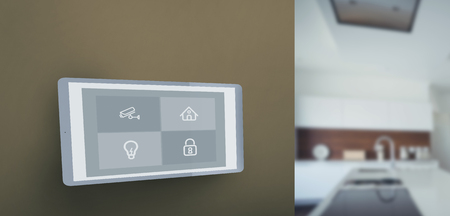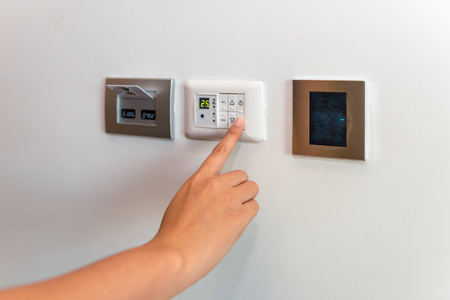Introduction to Smart Thermostats
Smart thermostats have quickly become a staple in many American households, thanks to their ability to make home heating and cooling more efficient and convenient. Unlike traditional thermostats, these smart devices can be controlled remotely via smartphone apps, voice assistants like Alexa or Google Home, or even through automated schedules that adjust temperatures based on your daily routine. The popularity of smart thermostats is driven by their promise to reduce energy bills, provide greater comfort, and help homeowners play a part in environmental sustainability. With features like real-time energy usage tracking, learning algorithms that adapt to your preferences, and integration with other smart home devices, it’s easy to see why so many Americans are making the switch. However, as we invite these connected devices into our homes, it’s important to consider not just the benefits but also the potential security and privacy risks they may bring.
2. How Smart Thermostats Collect and Use Data
Smart thermostats do much more than simply control your home’s temperature—they collect a range of data to function efficiently and deliver personalized experiences. Understanding what types of data are gathered, why this information is important, and how it can benefit you as a consumer is crucial when considering security and privacy risks.
Types of Data Collected by Smart Thermostats
| Data Type | Description |
|---|---|
| Temperature Settings | Your preferred heating and cooling preferences throughout the day. |
| Occupancy Patterns | Information about when people are home or away, often tracked through motion sensors or smartphone integration. |
| Location Data | Some models use GPS data from smartphones to determine if youre at home or away. |
| Device Usage Logs | Records of adjustments made to the thermostat, either manually or automatically. |
| Wi-Fi Network Information | The name and status of your home Wi-Fi network for device connectivity. |
| Energy Consumption Data | Details on how much energy your HVAC system uses over time. |
Why Is This Data Gathered?
Smart thermostats collect these data points for several reasons. First, they use them to optimize your homes climate control, learning your daily routines to ensure comfort while minimizing energy waste. Second, usage patterns help manufacturers improve their products by understanding common behaviors. Third, aggregated data allows utility companies to design incentive programs that encourage energy efficiency.
How Does This Benefit Consumers?
- Convenience: Automated adjustments based on your schedule reduce the need for manual changes.
- Energy Savings: Learning algorithms lower energy bills by running your HVAC system only when needed.
- Personalized Recommendations: Insights into your habits can lead to tips for further savings or comfort improvements.
- Remote Access: Control your thermostat from anywhere using your smartphone or smart home hub.
- Potential Rebates: Participation in utility programs may earn you rebates or discounts on energy bills.
Key Takeaway:
The collection of personal and environmental data by smart thermostats brings significant benefits but also raises important questions about security and privacy. Knowing exactly what information is being gathered—and how it’s used—can help you make informed decisions about integrating these devices into your home.

3. Potential Security Risks
Smart thermostats offer a lot of convenience, but they also introduce new security risks that every homeowner should be aware of. One major concern is the threat of hacking. Because smart thermostats are connected to the internet, hackers can potentially exploit vulnerabilities in their software or in your home Wi-Fi network. Once inside, cybercriminals could take control of your thermostat settings or even use the device as an entry point to access other smart devices on your network.
Unauthorized access is another serious risk. If someone gains access to your thermostat—either through weak passwords or outdated firmware—they could gather sensitive information about your daily habits and routines. For example, knowing when youre usually home or away makes it easier for intruders to plan break-ins. This kind of data exposure goes beyond simple discomfort; it could have real safety implications for you and your family.
Real-world incidents have already highlighted these dangers. There have been reports of hackers remotely adjusting temperature settings to extreme levels, causing not only inconvenience but also potential damage to heating and cooling systems. In some cases, attackers have locked users out of their own devices, demanding ransom payments for restored access. These stories underscore the importance of taking smart thermostat security seriously and staying informed about the latest threats and best practices.
4. Privacy Concerns for Homeowners
When it comes to smart thermostats, homeowners should be aware that these devices collect a significant amount of personal and behavioral data. This includes information about your daily routines, when you are home or away, temperature preferences, and sometimes even occupancy patterns. Many smart thermostat brands store this data in the cloud, where it can be accessed by the manufacturer or third-party partners. The main privacy concern arises when this sensitive information is exposed, sold, or tracked without your explicit consent.
How Data May Be Exposed or Tracked
Smart thermostats often connect to other devices and platforms in your home through Wi-Fi or smart home hubs. If these connections are not properly secured, hackers can potentially gain unauthorized access to your data. Additionally, some companies may share aggregated user data with advertisers or analytics firms, which could lead to targeted advertising or profiling based on your home habits. Even if the data is anonymized, there is always a risk that it could be re-identified.
Common Data Shared by Smart Thermostats
| Type of Data | Potential Use | Who Might Access It |
|---|---|---|
| Location Information | Adjusting temperature based on proximity | Manufacturers, third-party apps |
| Behavioral Patterns | Energy usage analysis, targeted ads | Data brokers, marketers |
| Device Usage Logs | Troubleshooting, product improvement | Tech support teams, developers |
| User Preferences | Personalized recommendations | Advertisers, service providers |
The Risk of Data Sale and Profiling
A key issue in the U.S. is that privacy regulations differ by state, and many smart device companies include clauses in their terms of service that allow them to sell or share your data with business partners. This can result in detailed profiles about your lifestyle being created and sold without your knowledge. For American homeowners who value privacy and control over their personal information, its essential to review privacy policies carefully and opt out of unnecessary data sharing whenever possible.
5. Protecting Your Device and Data
Securing your smart thermostat is just as important as locking your front door. With the rise of connected home devices, taking steps to protect both your device and your personal information is essential. Here are some best practices and practical tips to keep your smart thermostat—and your privacy—safe.
Change Default Passwords Immediately
One of the most common mistakes people make is sticking with the default password that comes with their smart thermostat. Always create a strong, unique password that includes a mix of letters, numbers, and symbols. Avoid using easily guessed information like birthdays or pet names.
Enable Two-Factor Authentication (2FA)
If your smart thermostat’s app or web portal offers two-factor authentication, turn it on. This extra layer of security makes it much harder for someone to access your system—even if they get ahold of your password.
Keep Software Up to Date
Manufacturers regularly release firmware updates to patch vulnerabilities and improve security. Set your device and its app to update automatically if possible, or check for updates manually on a regular basis.
Secure Your Wi-Fi Network
Your thermostat connects to your home Wi-Fi network, so securing your router is critical. Use WPA3 encryption if available, and set a strong password for your Wi-Fi. Don’t use open or unsecured networks for any smart home devices.
Be Cautious with Third-Party Integrations
Many thermostats work with other smart home gadgets and platforms, but each connection is a potential risk. Only integrate with trusted services, and review what data you’re sharing before enabling new features or skills.
Limit Data Sharing and Review Privacy Settings
Dive into the privacy settings within your thermostat’s app. Opt out of unnecessary data sharing whenever possible, and periodically review permissions to ensure you’re only sharing what’s essential for operation.
Monitor for Unusual Activity
If you notice strange behavior—like settings changing without explanation or getting locked out of your account—take action right away. Change passwords, check for unauthorized devices connected to your network, and contact customer support if needed.
By following these practical steps, you can enjoy the convenience of a smart thermostat while keeping your data safe from prying eyes. Taking a proactive approach not only safeguards your privacy but also gives you peace of mind as you embrace smarter living at home.
6. Current Regulations and Consumer Rights
When it comes to smart thermostats, understanding the legal landscape is crucial for protecting your security and privacy. In the United States, several federal and state laws impact how your personal data is collected, stored, and shared by smart device manufacturers. While there’s no single federal law specifically regulating smart thermostats, broader legislation like the California Consumer Privacy Act (CCPA) and the Children’s Online Privacy Protection Act (COPPA) set important precedents for consumer rights in the realm of connected devices.
Federal Laws and Industry Standards
The CCPA gives California residents more control over their personal information, including the right to know what data is being collected and to request deletion or opt-out of data sales. Even if you don’t live in California, many companies extend these protections nationwide due to the state’s influence. Meanwhile, the Federal Trade Commission (FTC) enforces rules around deceptive or unfair business practices, which includes misleading privacy policies or inadequate security measures on smart home devices.
Industry Self-Regulation
Apart from government regulations, many smart thermostat manufacturers follow industry standards such as those set by the National Institute of Standards and Technology (NIST) and participate in privacy certification programs. These initiatives encourage best practices in data security and transparency but are largely voluntary.
Your Rights as a Consumer
You have the right to review a manufacturer’s privacy policy before purchasing or activating a smart thermostat. Most companies must disclose what information they collect, how it’s used, and with whom it may be shared. You can often adjust privacy settings within the device app, limit data sharing, or revoke access for certain third-party integrations. Additionally, you’re entitled to contact customer support to ask questions about your data or file complaints if you believe your rights have been violated.
As awareness grows around digital privacy, expect more states to adopt comprehensive privacy laws similar to California’s. In the meantime, staying informed about your rights and reading device documentation carefully are key steps toward protecting your information when using smart thermostats in your home.
7. Conclusion and Future Outlook
As smart thermostats become increasingly popular in American homes, its crucial to recognize the security and privacy challenges they present. Throughout this article, weve highlighted key risks such as unauthorized data access, potential hacking, and the collection of sensitive household information. Users must remain vigilant by practicing good password hygiene, regularly updating firmware, and understanding what data their devices collect and share.
On a broader scale, technology is rapidly evolving to address these issues. Manufacturers are now incorporating advanced encryption protocols and more transparent privacy settings into their products. At the same time, policymakers are beginning to introduce regulations that require clearer disclosures and stronger protections for consumers. Emerging trends like edge computing—where data is processed locally rather than sent to the cloud—and increasing user control over data sharing are promising steps forward.
Looking ahead, both technological innovation and legislative action will continue to shape how smart thermostats balance convenience with security and privacy. As awareness grows and standards improve, users can expect smarter safeguards without sacrificing the benefits of connected home technology. Staying informed and proactive remains the best way for individuals to protect themselves while enjoying all that smart thermostats have to offer.
